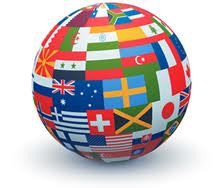
In business, there's always another mountain to climb. A company can't remain static, and one avenue that's worth considering is international business. There's a global market out there, and it's waiting for you to jump in and make your presence known. An international operation opens an entirely new market to boost your clientele and sales. Instead of competing in an over-saturated marketplace, positioning yourself internationally allows you to tap a new venue that may have an underdeveloped customer base. Before jumping into an international arena, market research is critical to the success of your venture. Regardless of the success you've achieved nationally, there are a number of factors to consider for positioning your company in the international marketplace. Cultural differences, political climate and a country's economy all play a part in your decision to expand your business internationally.
Steps in the Market Research Process- 1. Locate Potential Markets
- Gather trade statistics to determine which countries use your services or import your products, and analyze available market research reports.
- Target major and fast-growing markets for your firm's products, and analyze your firm's market standing to get a clear picture of your company's position.
- Pinpoint smaller emerging markets that may have less competition, and focus on statistically promising markets for additional evaluation. - 2. Assess Your Target Market
- Examine the demographics, economy and consumption level of your target market. Determine the source and level of competition of domestic production as well as the export suppliers.
- Determine foreign barriers, U.S export stipulations and incentives for exporting your service or product.
- Make sure your product is competitively priced. Analyze all costs to include taxes, tariffs, commissions, packaging, shipping and marketing. - 3. Use a Test Market
- If this is your first foray into international marketing, start with a small test market with a few promising countries to gauge foreign interest in your products.
Why Is This Process Necessary?
- - Export.gov
- - United States Trade Representative (ustr.gov)
- - Michigan State University Business School (globaledge.msu.edu)
- - Federation Of International Trade Associations (fita.org)
- - Agriculture-Specific Requirements and Certifications
- - China Compulsory Certification
- - European CE Marking Guidance
- - International Organization for Standardization
- - Onerous or Discriminatory Certifications, Standards and Regulations
- - Packaging and Recycling Laws
Expanding your business to foreign markets is a costly proposition. There is a lot of legwork that needs to be done, and this alone is a significant outlay of man hours. Setting up the physical requirements to implement foreign sales can also be expensive and time consuming. Attempting to expand without due diligence would be foolhardy and could be financially disastrous.
Sources to Gather New Market InformationThe Internet provides a wealth of resources to assist in gathering information and making decisions about entering the international business marketplace. This short list will get you started and is merely a few of many sites that can help with every facet of taking your business to the next level.
Export regulations vary between countries, and there are restrictions and variances for different classes of products. It's imperative that you research your products, services and the countries with which you intend to do business. The Export.gov website has extensive information on regulations for exportation of various products to different countries.
International Requirements and Regulations for Foreign ExportationEach country sets its own requirements and regulations for importing goods and services. The most common categories of regulations and certification requirements include:
There are many other categories and issues that each country will address, and there are exclusions and bans on the importation of some items that may affect your ability to sell products in some countries.
Country Tax and Tariff CodesAs independent nations, each country has different taxes and tariffs. There are a number of fees that can be assessed, and there is a whole glossary of terms for these charges. With so many potential fees and variances of those fees based on the category of goods, the end use of the product, the importing nation and other variables, it's important to check for current information with each country. Export.gov has a useful webpage that includes tax and tariff information for each country. Armed with this information, you can objectively determine your total cost for producing your exportable items.







